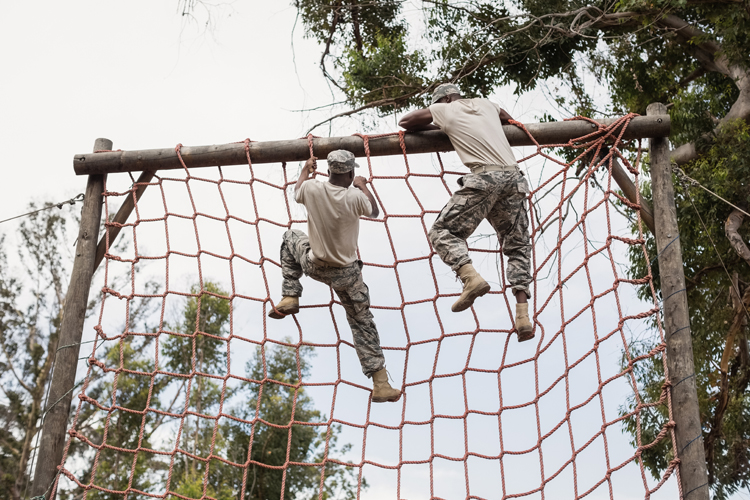Looking to build muscle endurance and improve body composition? Why not try military style training!
Military inspired training involving high-volume, low-intensity sessions can be an effective way to build muscle.
Here’s how Military Style Training helps:
- Multijoint, total body workout
- High-volume training
- Exercises with low loads
Multijoint, Total Body Workouts
Multijoint exercises including bench press, deadlift, squat and military press are effective in improving muscle mass, strength and power.
What sets multijoint exercises apart is that they combine multijoint total-body exercises (mentioned above) and less-common exercises such as bear crawls and full sit-ups to ensure simultaneous usage of multiple joints and muscles.
High-volume Training
Military training uses high-repetition sessions to build resistance. High-volume training is unique due to the amount of exercise it involves in one session.
This kind of training, when compared to traditional strength-training program, uses more number of sets compared to the general strength-training routine. For example: the German Volume Training (GVT) involves 10 sets of 10 repetitions, while traditional strength-training covers five steps of 10 repetitions. Researchers found that GVT had more effect on body-composition.
This indicates that high-volume training is effective in increasing lean body mass and decreasing fat mass.
Exercises with Low Loads
High loads are very effective in increasing muscle mass, strength and power. However, they cannot be used in high-volume sessions. Hence, these sessions need low-intensity loads.
To assess the impact of low-intensity loads on muscle strength, researchers measured muscle-endurance exercise results with high loads – 80 percent of one repetition maximum and with low loads – 30 percent of one repetition maximum.
The test results showed that the endurance of elbow flexor muscles increased in the low-intensity load group.
Full Body Circuit Military Workout
Today in our blog, we will provide you with high-volume military workout circuits that you can try.
You can perform these circuits including calisthenics, weights, a combination of both, along with a cardio exercise and suspension training. You can also try performing a mix of exercises you like and add some that lead you to identify your personal weaknesses.
To perform these circuits, you need to organize the movements intro groups of core/grip exercises, a range of cardio exercises including sprints, running and intervals, upper body push and pull and full body movements.
Here are the techniques:
Any exercise must begin with a warmup. The warmup can include a series of running, pushup/squats and running exercises. This can be done on an athletic field, a basketball or tennis court or even a driveway.
- Run for 25-50 m, followed by 1 pushup / 1 squat
- Run for 25-50 m, followed by 2-10 pushups / 2-10 squats
Repeat this routine for three-five times
This should be followed by:
- 10 jumping jacks or 20 jumps on a jump rope
- 10 squats
- 5-10 pushups
This warmup routine facilitates blood flow to the upper and lower body while alternating exercises with short spans of running or jumping to increase heart rate. You can include some dynamic stretches, including butt-kicker and Frankenstein walker between the 25-20 m runs.
Weights:

This circuit can include core, cardio, full, leg, pull and push exercises.
- 10 Bench Press or Dumbbell military press
- 10 Pulldowns or Dumbbell rows
- 10 Leg Press or Dumbbell squats
- 10 Multijoint Dumbbells or Thrusters
- 1 min of TRX Plank Pose
- 5 minutes of Rapid cardio with Tabata intervals to increase heart rate and challenge the fast-paced energy system
This routine should be repeated for 3-4 times
Calisthenics:
This circuit includes core, cardio, leg, full, pull and push exercises.
- 10-20 Pushups or Dips
- Max repetitions of pullups or assisted pullups
- 20 Squats or 10 Lunges
- 10-20 – Burpees
- 1 min of knees-up, sit-up or crunches
- 5 min of steady cardio
If you are experiencing pain in the shoulders, you can perform the Lightweight Shoulder workout to work as an upper body push for the entire shoulder.
Cooldown with easy and deep breathing cardio options or 10-15 min cardio exercises of your choice on an easy pace.
Being Prepared for the Risks
Any routine can have its side effects that are temporary or long-lasting. High-volume training with multijoint and total body exercises is no exception here.
It entails some risks including fatigue, injury and mechanics errors. Therefore, a certain level of caution needs to be maintained throughout the session. Here are some tips:
- If form is broken during one of those high-volume training sessions, it is advisable to take rest and continue post recovery
- Improper usage of this training can lead to overtraining and result in serious problems including Rhabdomyolysis that leads to release of muscle-fiber contents in the blood, causing kidney damage
- Alternate high-volume training sessions with low to moderate volume sessions, supported by moderate to high-load sessions
- If you experience symptoms such as exhaustion, extreme-thirst, heat-related illness, muscle pains and cramps, it is advisable to stop exercising immediately
Planning to try this routine? Why not engage a smart fitness tracking app?
Download Fitness AppMore Articles:
- How Much Water Should You Drink When You Exercise?
- Why am I always hungry? Reasons to Find Out Why?
- How to Keep a Balanced Diet While Travelling

